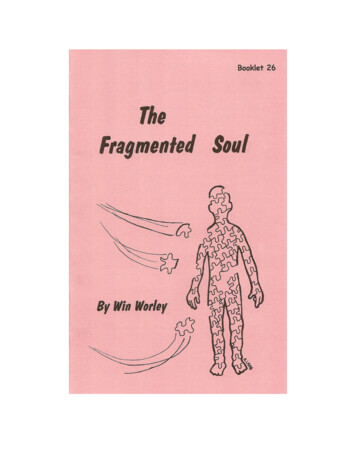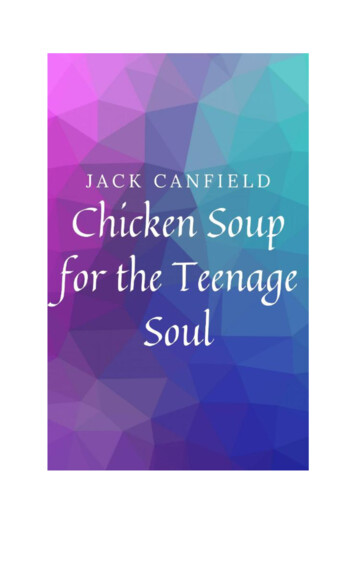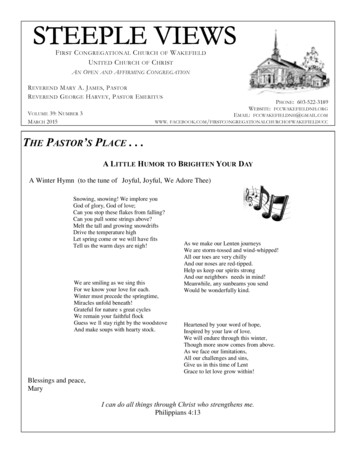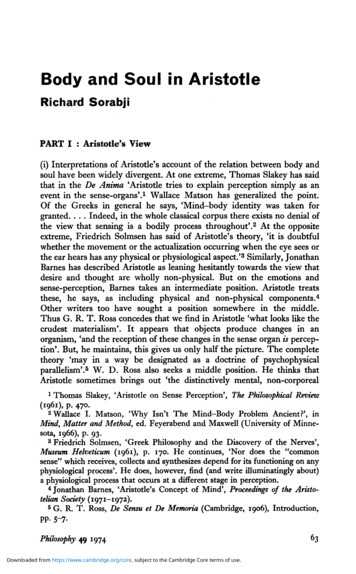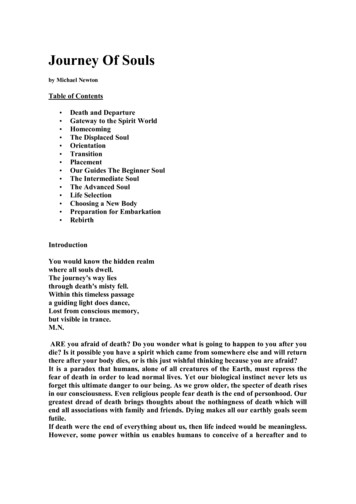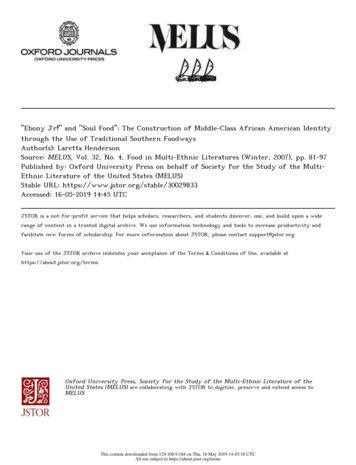
Transcription
"Ebony Jr!" and "Soul Food": The Construction of Middle-Class African American Identitythrough the Use of Traditional Southern FoodwaysAuthor(s): Laretta HendersonSource: MELUS, Vol. 32, No. 4, Food in Multi-Ethnic Literatures (Winter, 2007), pp. 81-97Published by: Oxford University Press on behalf of Society for the Study of the MultiEthnic Literature of the United States (MELUS)Stable URL: https://www.jstor.org/stable/30029833Accessed: 16-05-2019 14:45 UTCJSTOR is a not-for-profit service that helps scholars, researchers, and students discover, use, and build upon a widerange of content in a trusted digital archive. We use information technology and tools to increase productivity andfacilitate new forms of scholarship. For more information about JSTOR, please contact support@jstor.org.Your use of the JSTOR archive indicates your acceptance of the Terms & Conditions of Use, available athttps://about.jstor.org/termsOxford University Press, Society for the Study of the Multi-Ethnic Literature of theUnited States (MELUS) are collaborating with JSTOR to digitize, preserve and extend access toMELUSThis content downloaded from 129.108.9.184 on Thu, 16 May 2019 14:45:18 UTCAll use subject to https://about.jstor.org/terms
Ebony Jr! and "Soul Food": TheConstruction of Middle-ClassAfrican American Identity throughthe Use of Traditional SouthernFoodwaysLaretta HendersonUniversity of Wisconsin-MilwaukeeDuring the post-World War II era the United States saw an unprecedented expansion of the black middle class and a new level ofblack middle-class prosperity. Yet this expansion led many to questionwhat constituted "authentic" blackness. E. Franklin Frazier's unflattering portrayal of the black middle class in Black Bourgeoisie (1957),for example, attacked the black middle class as assimilationist. In the1960s and the 1970s the Black Arts Movement, from which the blackaesthetic arose, redefined black art by designating the black community as its audience, as opposed to art which was more committed tothe struggle for human and civil rights and for interracial relations.Hostile to the assimilationist tendencies of the black middle class, theBlack Arts Movement sought to shatter middle-class decorum andhelp black people, in the words of Addison Gayle, break out of the"polluted mainstream of Americanism" (xxii).The black middle class responded to these cultural developments innumerous ways, attempting to create a strong sense of self-definitionthrough art, politics, and, most relevant to this essay, food. Not onlywere systems such as art and politics evaluated and redefined, but alsoincluded in this redefinition was the human body and everything associated with it, including food consumption. According to WilliamVan Deburg, the concept of "soul [that arose in the 1960s] was thefolk equivalent of the black aesthetic. [As the essence of black culture], soul was closely related to black America's need for individualand group definition" (195). In its culinary incarnation, "soul food"was associated with a shared history of oppression and inculcated, bysome, with cultural pride. Soul food was eaten by the bondsmen. It wasalso the food former slaves incorporated into their diet after emancipation. Therefore, during the 1960s, middle-class blacks used theirMELUS, Volume 32, Number 4 (Winter 2007)This content downloaded from 129.108.9.184 on Thu, 16 May 2019 14:45:18 UTCAll use subject to https://about.jstor.org/terms
82HENDERSONreported consumption of soul food to distance themselves from thevalues of the white middle class, to define themselves ethnically, and toalign themselves with lower-class blacks. Irrespective of political affiliation or social class, the definition of "blackness," or "soul," becamepart of everyday discourse in the black community.Foodways and African American IdentityFactors such as a common culture, history, and civic ideology contribute to the creation of a group-based identity. According to ClaudeFischler, "Food is central to our sense of identity. The way any givenhuman group eats helps to assert its diversity [and] hierarchy . . andat the same time, both its oneness and the otherness of whoever eatsdifferently" (275). And since meaning is attached to the separation ofthe culinary habits of various groups, food is also used to differentiate among groups. Foodways become "associated with nearly everydimension of human social and cultural life" (Gabaccia 8). Specificfoods become entwined with holidays, group history, and the healthof the community. According to cultural anthropologist MargaretMead, how adults teach children to eat plays an important role in theproduction and reproduction of food moralities (227-28). Foodwaysand identity intersect, as does the power relationship between adultsand children. Either explicitly and consciously or implicitly and uncon-sciously, adults teach children foodways that are often associated withtheir ethnic identity.A term coined in the North, "soul food," was part of a self-definingdiscourse of the 1960s and 1970s. Some commentators, such as AmiriBaraka (then known as LeRoi Jones) "began valorizing it as an ex-pression of pride in the cultural forms created from and articulatedthrough a history of black oppression" (Witt 80). Scholars define soulfood in terms of three attributes: a connection to Africa and the dietof enslaved blacks, something inherent in the black body, and a tool todefine a black identity (Baraka, Van Deburg, Witt). Van Deburg statesthat soul food originated in Western Africa and was transported tothe American South with the slave trade (203). Baraka also used soulfood to show connections within the African diaspora, whether it wasingredients such as black-eyed peas, collard greens, and okra, or cooking methods such as deep-fat frying (102). In Black Hunger, Doris Wittstates that "the emergence of soul food should be construed not justsynchronically but also diachronically, as a part of an ongoing debateamong African Americans over the appropriate food 'practices' ofblackness" (80). Soul food was encoded with blackness.Some scholars and culinary critics such as Van Deburg and CraigClaiborne differentiate between soul food and traditional southernfoodways. For Van Deburg, ingredients such as "hog maws, neckbones, ham hocks, [and] chitterlings" were components of soul food,This content downloaded from 129.108.9.184 on Thu, 16 May 2019 14:45:18 UTCAll use subject to https://about.jstor.org/terms
TRADITIONAL SOUTHERN FOODWAYS83since "southern bondsmen" transformed them into "a gourmlight" (203). These ingredients-pieces of the pig that the white plantation owners did not want-along with cornmeal, were the core of thebondsmen's diet. As the diet of most blacks' ancestors, these elementswere considered the definitive ingredients of soul food. "Althoughcollard greens, black-eyed peas, hush puppies, deep-fried chicken, andcatfish may have appeared on both white and black tables in the antebellum South, it seemed to take a black hand in the kitchen beforeany recipe could be considered 'soulful"' (Van Deburg 203). Claiborneconcurred, defining "typical Southern dishes as fried chicken, spareribs, candied yams and mustard or collard greens . [And soul foodas] trotters, neckbones, pigs' tails and chitterlings" (109).While Van Deburg and Claiborne made such distinctions, mostblacks did not. For them, the difference between traditional southernfood and soul food was not contained in the ingredients but in the bodyof the cook. Only blacks cooked soul food; whites produced a "thin. parody" (Van Deburg 203). Others, such as Elijah Muhammad, theleader of the Nation of Islam, and Dick Gregory, a Civil Rights activist and nutritional consultant, sought to distance the black communityfrom its slave past and diet by condemning it as an "unclean and/orunhealthful practice of racial genocide" (Witt 80). According to them,soul food was the "garbage" of white plantation owners, and blacksdeserved more than garbage.As adults sought to define authentic blackness they also includedchildren in this discourse. James Comer and Alvin Poussaint, authorsof Black Child Care: How to Bring up a Healthy Black Child in America, statethat children as young as four are aware of their subjectivity and arebeginning to have an "interest in characteristics or behavior having todo with what adults call race, nationality, or religion" (20). Therefore,writers and publishers of black children's literature in the 1970s whodiscussed race were aligned with child development theorists in assuming that their child readership, including four-year-olds, was interestedin defining themselves as racialized beings.In this article, I discuss how ethnic identity, or "blackness," is posited to the racialized child reader of Ebony Jr! (EJ), a magazine forblack children published from 1973 until 1985.1 As food was used toauthenticate black middle-class identity for adults, so, too, food in EJwas linked to ethnic identity and authenticity in the narratives, activitysheets, and cooking columns. Although there are various definitions ofsoul food among scholars and food critics, for the purposes of this article, I will use the common definition of soul food-traditional southern food cooked by blacks, since it was the one used by the editors ofEJ. While their definition incorporated intuition and cooking method,they did not differentiate among ingredients. For them, soul food wasdefined as traditional foods consumed by blacks who had migratedfrom or still resided in the South. This idea is supported in a cartoonThis content downloaded from 129.108.9.184 on Thu, 16 May 2019 14:45:18 UTCAll use subject to https://about.jstor.org/terms
84HENDERSONtitled "Soul Cook-Out," in which three children are shownthe backyard of a home while a man stands over a barbecua spatula in his hand. This man wears a chef's hat and a white aprondenoting him as the cook, and there are hamburgers on the grill. Thetext reads, "Even hamburgers have lots of soul when they're cookedwith sauce over red hot coals" (56). This statement tells us that evensomething as mainstream as a hamburger can be transformed into soulfood if it is cooked by a black person and in a certain way ("with sauceover red hot coals"). Furthermore, it appears that the editors of EJdid not differentiate between traditional southern black food and thatconsumed by southern whites. But, they did differentiate between soulfood as the core of the black diet and everything else.Yet the editors understood that a portion of their audience woulddisavow ingredients considered the garbage of white slave owners: hogmaws, neckbones, pigs' tails and feet, and chitterlings. Therefore, theytended not to mention these ingredients, perhaps to avoid alienatinga portion of their black audience. Despite the omission of some keyingredients, the editors still insisted that through the production andconsumption of the soul food mentioned in EJ, readers could affirmtheir black identity. Foods from the African diaspora, most commonlyfoods from Africa and the Caribbean, also defined the reader as blackin a global sense and connected the reader to blacks around the world.The child reader was constructed as either familiar with the foodwayspresented or at least interested in them, and the diaspora's foodwaysconnected them to a racial and global identity.The Food of EJThe climate in the black community at the inception of EJ wasone of social and economic gain as a result of the Civil Rights movement, surrounded by a discourse on the definition and politicization of"blackness." The discourse on blackness included education, politics,and the body. Naturally textured hair and Afrocentric and fashionableclothing were used to construct identity on the exterior. EJ was clearly aligned with the politics of the 1960s and 1970s that emphasizedblack self-definition. In an effort "to recreate their identity on the basisof cultural continuities rather than on the simplistic [and oppressive]caste-racial criteria" (De Vos 22), blacks in general rejected the whitesupremacist state governmental "one-drop rule" that mandated thata single drop of "black blood" makes a person black. Instead, blackscholars and activists looked to Africa and the African American community for a definition of who and what was black (Bahr, Chadwick,Stauss). EJ was an educational tool, one that contained an academicand ethnic curriculum. Through food, an identity was offered to childreaders in an effort to assist them in defining themselves as black andconnected to diaspora.This content downloaded from 129.108.9.184 on Thu, 16 May 2019 14:45:18 UTCAll use subject to https://about.jstor.org/terms
TRADITIONAL SOUTHERN FOODWAYS85Like various media projects of the early 1970s, children's period-icals, such as EJ, were a popular educational tool. Launched underthe editorship of Constance Van Brunt Johnson, EJ was publishedby Johnson Publishing Company, a multimillion dollar company privately held by a black family. Ebony (1945-present), the cornerstone ofJohnson Publishing Company, is an entertainment, picture magazinethat focuses on images of blacks. It had a circulation of 1.8 million in1975 (Hoover Report), with a much larger readership since each Ebonysold probably was read by five people ("Backstage" 25).EJ, published monthly except for two bimonthly summer issues,was geared for children from five to eleven; it contained "stories, ar-ticles, word and mathematical games, songs, contests, and a calendarof events in the lives of black Americans" (Daniel 164). In the announcement for the magazine, John H. Johnson, publisher and founder of Johnson Publishing Company, stated, "Ebony Jr!is not a youngerversion of Ebony, but a completely different magazine. . . . It is intended to motivate reading mastery and strengthen the preparednessof Black children for a highly literate future" ("Johnson Introduces"52). According to an article celebrating Ef's tenth anniversary, "circulation is approximately 200,000 and the magazine is used throughoutthe nation's elementary school system as a learning tool" ("Ebony Jr!Celebrates" 14). Finally, although EJ was written for children, Johnsonwas clear that his primary market was adults. Parents and teachers purchase children's texts and Johnson knew that education was an excellent marketing appeal for this audience. But he also knew that childrenhad to enjoy the magazine or they would not request it; therefore EJpresented learning as fun by referencing popular culture and includingactivity sheets that made it interesting. This dual strategy is clear, aswhen Johnson states:Ebony Jr!is about learning and exploring. It is based on the idea that learning is fun. It is based on the idea that reading is the door to opportunity.It is based on the idea that exploring new worlds . is half the fun ofgrowing up committed and productive. For these reasons, Ebony Jr! willbe a magazine of action. It will be filled with things to do. ("Why EbonyJr?" 4)EJ emphasized the importance of basic literacy skills (reading, math,and science skills) along with a curriculum that connected black children to a racialized history in the United States and the African diaspora.At the beginning of her tenure, Van Brunt Johnson, EJ's foundingeditor, took the opportunity to associate soul food with the reader'sethnic identity. In conceptualizing blackness, EJ incorporated food asa way to immerse readers in their culture. Therefore, for the most part,only soul food and foodways of the African diaspora are used in EJ.This content downloaded from 129.108.9.184 on Thu, 16 May 2019 14:45:18 UTCAll use subject to https://about.jstor.org/terms
86HENDERSONThis discourse was extended to the entire range of Efs auto eleven-year-olds) since the skill level of the recipes vaall elementary school-aged children. Although they are nsociated with soul food, the recipes for "Icy Cold Treats"and Shirley Searcy's "A Health Food Delight: Carrot Cookies" (24-25)demonstrate that the food column included articles for all of EJ's readers, regardless of their age.The "Icy Cold Treats" recipe for frozen treats made from Ktargeted the younger range of the intended audience, while "A HealthFood Delight: Carrot Cookies" targeted older readers. Without posing harm, and only minimal mess, a child as young as five could easilymake Icy Cold Treats. The recipe required the child to pour preparedKool-Aid into an ice tray, cover the tray with plastic wrap, and inserttoothpicks into the individual molds before putting the ice tray intothe freezer. The child might spill Kool-Aid, but no sharp objects or theoven are required to make Icy Cold Treats, making it accessible to afive-year-old child. Since a knife, grater, and oven are required to makeSearcy's carrot cookies, and adults are absent from the illustration andinstructions, this recipe targeted older children.Regardless of the age of the target audience, for the most part,the Afrocentric orientation remained consistent. EJs first cooking column, "Baking Powder Biscuits," was accompanied by photographs ofTeesha, a girl, and Thomas, a boy, who, according to the introduction,had written out the recipe. As in most of the child-centered recipesand food narratives, both genders are shown actively preparing thefood. Even though the children are shown using an oven, there is noadult present. The article uses a font that simulates the handwriting ofan elementary school child, one who fails to write in a straight line; thismakes it appear that a child copied the recipe and helps the child readerconnect with the text and with EJ.In her article, "Soul, Black Women, and Food," Marvalene Hughesstates that homemade biscuits are a staple in the breakfast of a "typicalBlack kitchen" (278), a breakfast which, according to Hughes, "mostoften consists of grits, homemade biscuits, ham or bacon, molassesor canned preserves, fresh milk, and fresh eggs" (278). She notes that,"There is supreme value, culturally, in the preparation of a 'hot meal'for breakfast. When the black child goes to school, a caring other seesthat she or he has had a 'hot meal"' (278). Evidently the editors of EJwanted children to know how to make a component of such a "hotmeal" in accordance with the tenets of "a typical black kitchen."The introduction to the recipe for baking powder biscuits states:"The recipe comes from Johnson Publishing Company's, The Soul ofGood Cooking" (31). However, The Soul of Good Cooking is in fact only aportion of the title of the referenced cookbook. The whole title is: TheIntegrated Cookbook: The Soul of Good Cooking. This book featured soulfood and mainstream dishes. Even though Freda De Knight publishedThis content downloaded from 129.108.9.184 on Thu, 16 May 2019 14:45:18 UTCAll use subject to https://about.jstor.org/terms
TRADITIONAL SOUTHERN FOODWAYS87The Ebony Cookbook: A Date with a Dish: A Cookbook of AmerRecipes with Johnson Publishing Company in 1948, 1962, andeditors chose the biscuit recipe from The Integrated Cookbook:Good Cooking. The failure to reference the "Integrated Cookbtion of the title in the introduction might speak to the editors' desireto concentrate on formulating a black identity through soul food. Oneof the primary goals of the magazine was to provide the black childreader with "a magazine which reflect[ed] the sounds and sights andcolors of [their] community" ("Why Ebony Jr." 4). EJ served as a mirror in which black child readers could see their reflection and constructan almost exclusively black world-other races are rarely shown in EJ.The idea was to provide the child with a foundation in black historyand culture to augment the Eurocentric education most black childrenreceived in school. Therefore, grounding the reader in a black identitywas far more important than a discourse on integration. The editorsmay have been more concerned with defining blackness through soulfood, and they may have deleted the term "integration" to stay focusedon the magazine's racialized agenda.This thread continues in most of the narratives where ftioned, such as in the excerpt from Norma Poinsett's "Susa's Natural."Although it is a story about Susa's desire to wear an Afro, anothermarker of blackness, food is nevertheless mentioned:Mama finished washing the potatoes and emptied the peelings into thegarbage can. She'd stew the potatoes and season them with butter, baconbits and onions. She loved to season food just right. Then she'd add somegrated cheese and just the right amount of salt and pepper. Food neededto have a bottom in it, soul, Mama thought. Then she cut up a chickenand seasoned it. She'd fry it for dinner. While at the refrigerator, she tookout turnip and mustard greens. In no time she picked and washed thegreens and stuffed them in a pot that was bubbling on the stove. (51)Not only does the mother cook foods traditionally associated with soulfood, she cooks according to some definitions of the "soul food" aes-thetic, intuitively, and with seasoning. Since the assumption in someparts of the black community was that white foodways adhere to standardized recipes and lack improvisation, the reference to the intuitionthe mother uses while cooking is aligned with those who define soulfood as located within the black body and various methods of foodpreparation, rather than within the ingredients of a particular dish.In addition to narratives, food was also the focus of some of theeducational activity sheets. Usually, when food was mentioned, it wassoul food. One example is "Picnic Lunch," where the reader is instructed to unscramble the words for the dishes that are in the picnicbasket. The menu consists of typical soul food fare: fried chicken, potato salad, baked beans, lemonade, and watermelon. For some reason,This content downloaded from 129.108.9.184 on Thu, 16 May 2019 14:45:18 UTCAll use subject to https://about.jstor.org/terms
88HENDERSONhot dogs and celery are included in the picnic lunch as wewhich are elements in soul food or traditional southern chot dogs may have been added to appeal to younger readeaddition of celery would please nutrition-conscious adults. But the inclusion of non-soul food items was rare. Watermelon, long associatedwith blacks, was the subject of the food segment in this same issue,with the children making watermelon sherbet.EJ's Response to Differences within Black FoodwaysAlongside narratives and activity sheets, readers' responses werealso constructed to support the soul food aesthetic. Darrick Wilson,winner of the October 1973 annual writing contest, included the following passage in his story "Mom's Sad and Happy Event": "Momwas in the kitchen cooking our favorite meal for dinner, which wasred beans and rice, cornbread, baked neckbones and a peach cobbler"(25). Clearly the child reader was constructed as complicit in positing soul food as the culinary choice of Efs readers. But, interestinglyenough, this was one of the rare occasions when a dish that might becontroversial-a dish defined by scholars as soul food (neckbones)is mentioned. For the most part Efs definition of soul food was traditional southern foodways. While pork was problematized by ElijahMuhammad of the Nation of Islam as "unclean" and a type of "slavefood" (Witt 107), it was commonly mentioned in EJ, particularly in thesegments on barbecue.In essence, Muhammad instructed his community to reject porksoul food, by anyone's definition--because it was associated withslavery as the discarded foods of white slave owners and unhealthy; theincidences of diabetes, obesity, and heart disease in the black community were evidence of such. He also wanted his community to discarda slave-centered identity that was associated with these foods. Yet EJreclaimed these foods, devoid of a connection to slavery, or rather oppression, while firmly centered in a black past. Thus, food was anothertool used by Van Brunt Johnson to define and postulate a middleclass, Christian, and politically moderate (at least more so than thoseof the Nation of Islam) black identity for the child reader. All of thefoods Muhammad disallowed, except pigs' feet and tails and chitterlings, were regularly mentioned in EJ and almost none of the foods hesuggested-"brussels sprouts, asparagus, eggplant, okra, squash andrhubarb" (35)-were referenced. While one might say that many ofthe latter foods were undesirable to child readers, it should be notedthat okra, squash, and mustard and turnip greens are components ofthe soul food diet and are commonly consumed by some children.EJ was published by Johnson Publishing Company, a family ownedcorporation whose mission is to turn a profit. In evidence of this,John H. Johnson tended to avoid controversy. He also avoided anyThis content downloaded from 129.108.9.184 on Thu, 16 May 2019 14:45:18 UTCAll use subject to https://about.jstor.org/terms
TRADITIONAL SOUTHERN FOODWAYS89criticism of blacks in his publications. As a publisher, he was alwayscognizant of sales. This position is evident in the foods included andavoided in EJ. First, the editors never faltered on the value of positing these foodways as relevant to the construction of a black identity.But they tended to avoid mentioning foods that might be problematicfor a significant portion of Efs audience: hog maws, neckbones, pigs'tails, etc. Perhaps these very ingredients constitute soul food, but it isclear that the editors of EJ did not adhere to this definition. For theeditors, soul food was traditional, southern food cooked by blacks inan intuitive, innovative manner. For the most part, then, the foods thatare mentioned (fried chicken, watermelon, and beans) are more alignedwith traditional southern foodways than with scholars' definitions ofsoul food.In addition to class, politics, and, possibly, religion, gender issues in-tersect with food. Cognizant of gender politics and the black feministmovement, EJs editors showed boys in the cooking segments almostin equal proportion to girls. But if a man was cooking, it was usuallyin a conventional male setting-outdoor barbecuing. So, to a certainextent, EJ perpetuated conservative adult gender roles. For example, inPoinsett's "The Main Dish," the protagonist, Victoria, is upset becauseshe invited her teacher over for Thanksgiving dinner, forgetting thatthe family's oven was broken. Not wanting to embarrass Victoria, thefamily resolves to make dinner for the teacher. They all contribute tothe meal: "Judson [her brother] and Lois [her sister] had washed andsoaked fresh mustard and turnip greens from their garden and Mamapicked them. Victoria washed the sweet potatoes and cut up the onionsand peppers for the top-of-the-stove dressing" (8).Of course, it is a soul food menu and adheres to the soul aesthetic.The greens are not only "fresh" but from the mother's garden, andthus they have more value. Notice that Poinsett used the southernterm "dressing," as opposed to "stuffing," a Northern expression.Also noteworthy is the fact that Judson, Vicky's brother, helps cookinside the house. And the family can be forgiven for the top-of-thestove dressing because the oven is broken. But "Everybody was busyexcept Daddy, who kept going out for walks in the back" (8). While shefrets over having gotten her family into such a predicament, Victoriasits on the front porch crying:She was still feeling bad [and] . wondering what her parents had doneabout the oven when the first spicy scent of barbecue passed her nose. Itwas coming from behind the house. "Barbecue!" Victoria shouted, sniffing the air again to make certain she was smelling right . Victoria ranin the direction of the smell to see what was going on. Whoever heardof barbecue on Thanksgiving! She was out of breath when she finally raninto her father who was busy turning a spicket with a beautiful goldenreddish barbecued turkey on it. . He had dug a barbecue pit in theThis content downloaded from 129.108.9.184 on Thu, 16 May 2019 14:45:18 UTCAll use subject to https://about.jstor.org/terms
90HENDERSONground and filled it with hickory wood and was cooking up the besting turkey Victoria had ever sniffed! (9-10)While barbecuing a turkey is more aligned with traditional soufoodways, it is considered soul food by most blacks when theycooking. Therefore, the barbecued turkey is a welcome compona soul food meal. In relation to gender, barbecue has long beenated with males in the media, and EJ was no exception.Even the stock cartoon characters Sunny and Honey are used toperpetuate the conservative gender roles that place women (or girls) inthe kitchen and men in the world outside the kitchen. In the November1975 issue, Honey bakes a turkey and places it on the table (Davis 22).Sunny can be seen in another room sitting in a chair with his feet onan ottoman, reading a newspaper. In the next cell, Honey lights thecandles in the candelabra and the text reads, "I can tell that she bakedplenty" (22). Then, she looks around the corner as if calling Sunnyto the table; all the while a doll sits at the table with her head turnedto face the reader. One can assume that she is the speaker. As Honeycalls Sunny, the doll says, "But if Sunny gets his hands on it first, I'msure we won't get any" (23). By this time Sunny is sitting at the table,holding the turkey'and moving it toward his side of the table. Honeyand the doll have gloomy expressions on their faces. The assumptionis that Honey has baked the turkey but Sunny will eat the majority ofit, leaving little for Honey and the doll. One can also assume that sinceshe brought the turkey to the table while Sunny sat in the adjoiningroom, Honey cooked the turkey without his assistance.Because the column appeared in the November issue, the childrenare probably having their Thanksgiving dinner. This column displaysstereotypical gender roles in that Honey, the female, has baked the turkey in the oven and Sunny, the male, did not help
As the diet of most blacks' ancestors, these elements were considered the definitive ingredients of soul food. . (Van Deburg 203). Others, such as Elijah Muhammad, the leader of the Nation of Islam, and Dick Gregory, a Civil Rights activ-ist and nutritional consultant, sought to distance the black commu
